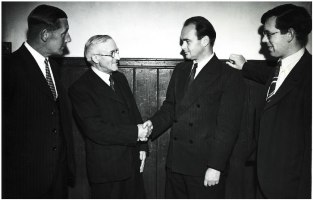Pike, Oliver
People > Oliver Pike
Oliver Gregory Pike was a pioneer in wildlife photography and cinematography, as well as being a fine naturalist and a prolific writer. He was born in Enfield on 1st October 1877. He moved with his family to Leighton Buzzard in 1922, where he made many wildlife films in his garden and in the locality. He travelled far and wide in Britain, lecturing, filming and photographing, but he loved his garden nature sanctuary as well as the local wildlife hotspots, such as King's Wood, Heath and Reach, where he spent many hours in his hide with a camera and notebook.
He started taking wildlife photographs in the 1890s. The procedure was difficult and the equipment cumbersome, so he designed a new camera called 'The Birdland', which was manufactured and sold widely from 1904 up to the First World War. A late example is held by the National Media Museum.
From 1906, he became interested in cinematography. He produced the first ever wildlife film that was shown to a paying audience in London in 1907. This was called 'In Birdland' and contained footage of seabirds around the east coast of Britain. Then he went to St Kilda and took the first film of the inhabitants of St Kilda in 1908. Although silent, black and white, and less than ten minutes long, it was described as a 'sensation' at the time. About 80 films followed, produced for the Pathe company, British Instructional Films, then Gaumont-British Instructional.
Oliver Pike's first book, called 'In Birdland with Field-glass and Camera' was published in 1900. It was very popular and went to six editions. In it, he not only wrote about the nature that he saw, but he also campaigned against the use of feathers in the ladies' hat trade. Later books included some aimed at children and others at prospective wildlife photographers, pointing out the best methods that he had developed over many years. Several of his books were translated and many were published abroad, particularly in Canada and the United States. He also wrote columns for national newspapers, as well as reports for magazines, especially on the rare birds that he had seen in his travels. He wrote or contributed to about thirty books, of which nearly half were written in his study at 'The Bungalow', Leighton Buzzard.
Oliver Pike served in aerial reconnaissance in the Royal Flying Corps (later the Royal Air Force) during the First World War. He left in 1919 with the rank of Captain. He served in the Bedfordshire Home Guard in the Second World War.
 After the end of the war, he helped to set up the
Bedfordshire Natural History Society and Field Club (now just the BNHS) and
became its first President in 1947.
After the end of the war, he helped to set up the
Bedfordshire Natural History Society and Field Club (now just the BNHS) and
became its first President in 1947.
In December 1948 he was made an Honorary Fellow of the Royal Photographic Society for his lifetime contribution to photography and service to the society. He had been a Fellow since April 1907 and served on the council from 1924 to 1948.
Oliver Pike died in Luton on 17th October 1963 and his remains were cremated in Bedford. His obituary was published in The Times. He was passionate about wildlife conservation and study, and he influenced many thousands of people through his films, books and lectures. A booklet by Rory Morrisey was published in 2013 by the Leighton Buzzard and District Archaeological and Historical Society. It is available to borrow from Leighton Buzzard library along with a collection of books written by Oliver Pike. The website www.olivergpike.info is dedicated to his work.
Page last updated: 3rd February 2014
